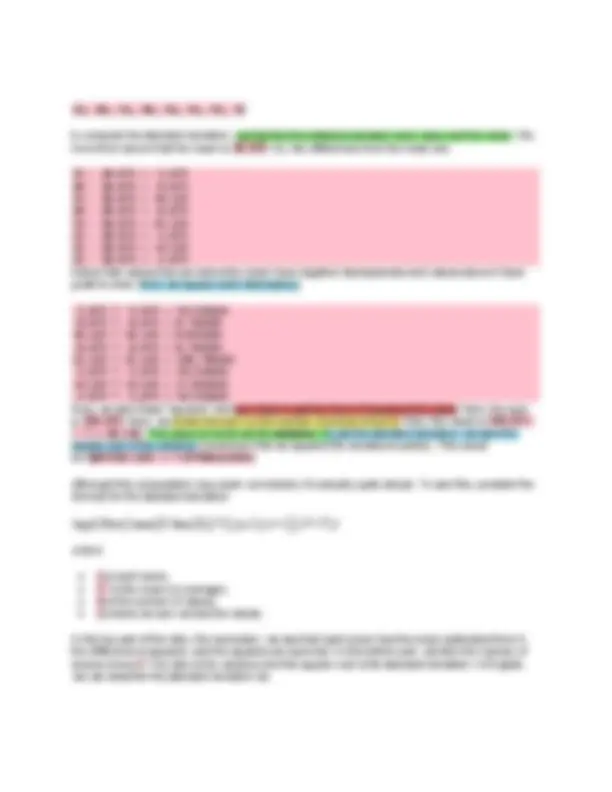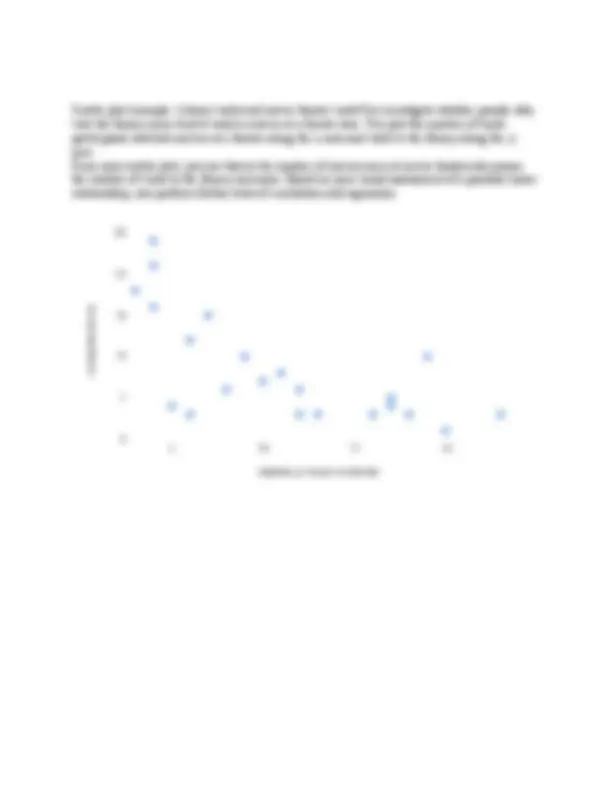










Study with the several resources on Docsity

Earn points by helping other students or get them with a premium plan


Prepare for your exams
Study with the several resources on Docsity

Earn points to download
Earn points by helping other students or get them with a premium plan
Community
Ask the community for help and clear up your study doubts
Discover the best universities in your country according to Docsity users
Free resources
Download our free guides on studying techniques, anxiety management strategies, and thesis advice from Docsity tutors
asdadasdas adsdsdadwaaadiofhseifbfobsvniosehfiancknsfihwio
Typology: Exercises
1 / 14

This page cannot be seen from the preview
Don't miss anything!









Descriptive statistics are used to describe the basic features of the data in a study. They provide
simple summaries about the sample and the measures. Together with simple graphics analysis, they
form the basis of virtually every quantitative analysis of data.
Descriptive statistics are typically distinguished from inferential statistics. With descriptive statistics
you are simply describing what is or what the data shows. With inferential statistics, you are trying to
reach conclusions that extend beyond the immediate data alone. For instance, we use inferential
statistics to try to infer from the sample data what the population might think. Or, we use inferential
statistics to make judgments of the probability that an observed difference between groups is a
dependable one or one that might have happened by chance in this study. Thus, we use inferential
statistics to make inferences from our data to more general conditions; we use descriptive statistics
simply to describe what’s going on in our data.
Descriptive Statistics are used to present quantitative descriptions in a manageable form. In a
research study we may have lots of measures. Or we may measure a large number of people on
any measure. Descriptive statistics help us to simplify large amounts of data in a sensible way. Each
descriptive statistic reduces lots of data into a simpler summary. For instance, consider a simple
number used to summarize how well a batter is performing in baseball, the batting average. This
single number is simply the number of hits divided by the number of times at bat (reported to three
significant digits). A batter who is hitting .333 is getting a hit one time in every three at bats. One
batting .250 is hitting one time in four. The single number describes a large number of discrete
events. Or, consider the scourge of many students, the Grade Point Average (GPA). This single
number describes the general performance of a student across a potentially wide range of course
experiences.
Every time you try to describe a large set of observations with a single indicator you run the risk of
distorting the original data or losing important detail. The batting average doesn’t tell you whether the
batter is hitting home runs or singles. It doesn’t tell whether she’s been in a slump or on a streak.
The GPA doesn’t tell you whether the student was in difficult courses or easy ones, or whether they
were courses in their major field or in other disciplines. Even given these limitations, descriptive
statistics provide a powerful summary that may enable comparisons across people or other units.
Univariate analysis involves the examination across cases of one variable at a time. There are three
major characteristics of a single variable that we tend to look at:
the distribution
the central tendency
the dispersion
In most situations, we would describe all three of these characteristics for each of the variables in
our study.
The distribution is a summary of the frequency of individual values or ranges of values for a variable.
The simplest distribution would list every value of a variable and the number of persons who had
each value. For instance, a typical way to describe the distribution of college students is by year in
college, listing the number or percent of students at each of the four years. Or, we describe gender
by listing the number or percent of males and females. In these cases, the variable has few enough
values that we can list each one and summarize how many sample cases had the value. But what
do we do for a variable like income or GPA? With these variables there can be a large number of
possible values, with relatively few people having each one. In this case, we group the raw scores
into categories according to ranges of values. For instance, we might look at GPA according to the
letter grade ranges. Or, we might group income into four or five ranges of income values.
Category Percent
Under 35 years old 9%
One of the most common ways to describe a single variable is with a frequency distribution.
Depending on the particular variable, all of the data values may be represented, or you may group
the values into categories first (e.g., with age, price, or temperature variables, it would usually not be
sensible to determine the frequencies for each value. Rather, the value are grouped into ranges and
the frequencies determined.). Frequency distributions can be depicted in two ways, as a table or as
a graph. The table above shows an age frequency distribution with five categories of age ranges
defined. The same frequency distribution can be depicted in a graph as shown in Figure 1. This type
of graph is often referred to as a histogram or bar chart.
Figure 1. Frequency distribution bar chart.
Distributions may also be displayed using percentages. For example, you could use percentages to
describe the:
percentage of people in different income levels
percentage of people in different age ranges
percentage of people in different ranges of standardized test scores
to compute the standard deviation, we first find the distance between each value and the mean. We
know from above that the mean is
. So, the differences from the mean are:
Notice that values that are below the mean have negative discrepancies and values above it have
positive ones. Next, we square each discrepancy:
Now, we take these “squares” and sum them to get the Sum of Squares (SS) value. Here, the sum
is
. Next, we divide this sum by the number of scores minus
. Here, the result is
/ 7 = 50.125. This value is known as the variance. To get the standard deviation, we take the
square root of the variance (remember that we squared the deviations earlier). This would
be SQRT(50.125) = 7.079901129253.
Although this computation may seem convoluted, it’s actually quite simple. To see this, consider the
formula for the standard deviation:
where:
X is each score,
is the mean (or average),
n is the number of values,
Σ means we sum across the values.
In the top part of the ratio, the numerator, we see that each score has the mean subtracted from it,
the difference is squared, and the squares are summed. In the bottom part, we take the number of
scores minus
. The ratio is the variance and the square root is the standard deviation. In English,
we can describe the standard deviation as:
the square root of the sum of the squared deviations from the mean divided by the number of scores
minus one.
Although we can calculate these univariate statistics by hand, it gets quite tedious when you have
more than a few values and variables. Every statistics program is capable of calculating them easily
for you. For instance, I put the eight scores into SPSS and got the following table as a result:
Metric Value
Mean 20.
Median 20.
Mode 15.
Standard Deviation 7.
Variance 50.
Range 21.
which confirms the calculations I did by hand above.
The standard deviation allows us to reach some conclusions about specific scores in our distribution.
Assuming that the distribution of scores is normal or bell-shaped (or close to it!), the following
conclusions can be reached:
approximately 68% of the scores in the sample fall within one standard deviation of the mean
approximately 95% of the scores in the sample fall within two standard deviations of the mean
approximately 99% of the scores in the sample fall within three standard deviations of the mean
For instance, since the mean in our example is
and the standard deviation is
, we
can from the above statement estimate that approximately 95% of the scores will fall in the range
of 20.875-(27.0799) to 20.875+(27.0799) or between 6.7152 and 35.0348. This kind of
information is a critical stepping stone to enabling us to compare the performance of an individual on
one variable with their performance on another, even when the variables are measured on entirely
different scales.
Next topic
Frequency distribution
Gender Number
Man 182
Woman 235
No answer 27
Measures of central tendency
Raw data Deviation from mean Squared deviation
M = 9.5 Sum = 0 Sum of squares = 421.
2
2
Univariate descriptive statistics
Visits to the library
Mean 9.
Median 7.
Mode 3
Standard deviation 9.
Variance 84.
Range 24
Bivariate descriptive statistics